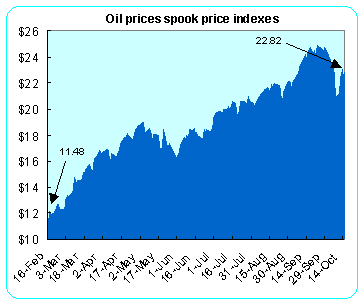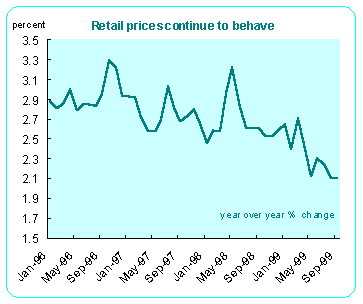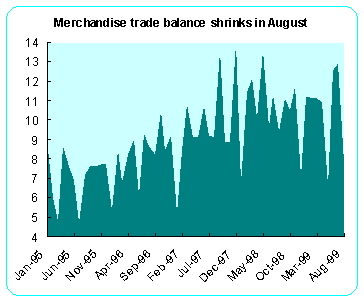|
International Perspectives - October 18, 1999
Anne D. Picker
International Economist, Econoday
A wicked market week...
An Update on Oil...
World oil prices have been increasing since mid February when the Organization of Petroleum Exporting Countries (OPEC) reduced the permitted output for its members. Since then, prices have doubled and have begun to filter through to countries' price indexes. Compliance by OPEC members with the self-imposed supply limits in September fell to 86 percent of a cumulative target from an estimated 94 percent in August. The temptation for the oil producing countries to increase production to cash in on higher prices - especially at prices above $22 - isn't unusual. Overall, oil has led the commodity price move upward.

Global oil demand is projected to climb thanks to recovering economic growth in both Asia and Europe. Despite increasing signs of economic recovery in Europe, competition in the power sector is tending to reduce reliance on residual fuel for power generation, largely offsetting growth in light transportation fuels demand.
The International Energy Agency released data that draw a puzzling picture of the world oil situation. Demand is rising and members of OPEC have cut back their output - but stocks of oil in industrial countries that are the largest consumers seem to have risen in the third quarter. Coming hard on the heels of the sharp drop in world oil prices last week, the IEA data suggest that something somewhere is awry. A whole lot of barrels aren't accounted for.
So far, major OPEC members have said they won't raise their output, at least until their next ministerial meeting in March. That is in keeping with a formal decision made last month. But oil experts think that OPEC's apparent unwillingness to consider opening the taps a little wider could backfire. Major OPEC members are unlikely to want to see exceptionally high prices, which would trigger another boom and bust cycle. The producing countries will put more oil on the market when needed to prevent that from happening.
Indicator Scoreboard...
Crude oil prices seeped into the producer price indexes last week, giving inflation a nudge up. The markets will be watching the consumer price indexes to see if the increased fuel costs are being passed onto the consumers.
Europe
Britain
Seasonally adjusted September input prices rose by 0.7 percent after increasing 0.6 percent in August. The climb in producer input prices were largely fueled by higher crude oil prices. September output prices including core prices, climbed at an annual rate of four percent in August to 5.8 percent, the highest annual rate since October 1995. Crude oil prices continued to exert the biggest upward effect on the index, jumping 7.2 percent on the month, despite the 1.1 percent rise in sterling/dollar exchange rates. The oil price impact was only partially offset by lower home produced food prices. Oil prices were up 72.9 percent on the year.
The annual rate of underlying inflation, RPIX (retail price index less mortgages), rose 0.4 percent on the month, while the annual rate was unchanged at 2.1 percent. This is under the Bank of England's 2.5 percent inflation target that is used in setting interest rates. The retail price index (RPI) rose 0.4 percent on the month and was unchanged at 1.1 percent when compared with a year ago.

The harmonized index of consumer prices in September rose by 1.2 percent when compared with a year ago. The harmonized index is constructed according to the criteria used by Eurostat, the statistical agency of the European Union, so that cross country comparisons can be made using uniform data.
A number of labor market indicators were released last week.
- Average earnings increased 4.9 percent when compared with last year in the three months ending in August, boosted by strong gains in private sector service firms. The result was well above expectations and the Bank of England's 4.5 percent threshold compatible with its inflation target. In May-July, the increase was 4.6 percent.
- The number of citizens unemployed and claiming benefits dropped again in September, but by significantly less than markets were expecting. The claimant count fell by 5,400 in September rather than the drop of 15,000 expected by the markets.
- Unemployment using International Labor Organization (ILO) measure in the three months to August fell by 83,000 when compared with the previous quarter and was down 106,000 on the year. The ILO unemployment rate fell to 5.9 percent from 6.2 percent in the previous month. The ILO measure includes people who are not eligible for unemployment benefits but are looking for jobs.
- The Labor Force Survey employmentlevel in the three months to August rose 99,000 when compared with the previous quarter and was up 294,000 when compared with the same period a year ago. The employment rate now stands at 74.1 percent, up from 74.0 percent last month.
EMU
Second quarter GDP growth among the European Monetary Union was revised up from preliminary data, to 0.5 percent and 1.6 percent when compared with the year earlier. The upward revision to the second quarter GDP provides more evidence that economic growth is picking up. The increase was due primarily to a strong upward revision in gross fixed capital formation. Private consumption also was revised up slightly, although public sector consumption was revised down somewhat. Exports and imports were both revised higher. As a result, net exports again contributed little to GDP despite the weak euro.

Industrial producer prices for August, excluding construction rose 0.3 percent in August and 0.5 percent from the level of a year earlier.
Germany
Final consumer price index for September fell 0.2 percent on the month but increased 0.7 percent on the year. The September data reinforces the perception that consumer prices remained subdued. Higher oil prices along with the effects from the recent weakness of the euro should put some upward pressure on consumer prices. But stronger competition along with deregulation in the communication and energy sector are likely to offset some of these pressures.
The August merchandise trade surplus was below expectations because of a strong increase in imports, which were up 10.9 percent on the year, while exports rose only 7.7 percent. Today's figures suggest that a strong contribution from net exports will not materialize in the third quarter. The decline of exports to countries other than those in the European Union suggests that Germany is not really benefiting from the recent weakness of the euro. However, the rise in the value of imports comes as no surprise given the recent increase in import prices and raw materials prices. In addition, the strong rise in imports suggests that domestic demand for imports is finally starting to pick up.

Seasonal and calendar-adjusted total real retail sales - including auto and gas station sales - rose 1.6 percent in August on the month and 1.5 percent on the year. The increase was slightly below expectations, suggesting some uncertainty about the strength of German consumer confidence and spending going forward.
France
The July current account surplus unexpectedly declined. The sharpest losses were recorded by the revenue accounts. The service sector surplus narrowed while the current transfers deficit widened. The only improvement came from a widening of the merchandise trade surplus, recording the best result since October 1997. Exports rose 3.8 percent on the month and imports were up 4.7 percent. As foreign direct investments in France fell sharply, the direct investment accounts posted a deficit. Portfolio investment accounts deteriorated as well, showing a surplus of 946 million euros, down from 3.221 billion in the previous month.
Spain
September consumer price index came in line with expectations, with the increase mainly due to higher energy and fresh food prices. The CPI is suffering from the effects of the global increases in oil prices, coupled with higher fresh food prices due to a drought followed by floods in the summer. Core consumer prices, however, were unchanged on the month and up 2.3 percent on the year. The 2.3 percent year-on-year core rate underlines that Spain has an inflation problem compared with the rest of the euro-zone, since it is coming from directions other than the "uncontrollable" sectors of energy and fresh food.
Italy
August industrial production posted a seasonally and workday adjusted increase of one percent and 7.3 percent when compared with last year. The surprising increase, however, pointed to the volatility of the August holiday season and the greater number of working days in August this year over last. Though officially there was only one more working day, 22 versus 21, unofficially many factories appeared to stay open longer this year as changes in working patterns emerge.
Asia
Japan
The August current account surplus slipped 32.7 percent from a year earlier. Goods and services trade posted a surplus but was down 63.5 percent. The surplus in merchandise trade fell 25 percent with exports down 6.4 percent and imports up 1.1 percent. A strong yen and higher oil prices curbed Japanese exports and boosted the value of imports. The trend toward a shrinking Japanese surplus is expected to continue in coming months, although resurgent exports to recovering economies across Asia will likely ensure that the pace of decline doesn't accelerate too much.
Americas
Canada
The 2.6 percent jump in September's consumer price index when compared with last year was primarily due to energy prices. Excluding the energy prices, the CPI rose 1.6 percent. The annual increase in the energy index was chiefly the result of accelerated growth in gasoline and fuel oil prices and of rising natural gas prices. The 0.3 percent increase in September was identical to that of July and August.
World Financial Markets
Equity markets...
Although Halloween isn't here yet, some market shenanigans started early. October is not a good month for markets and they enter into it with a foreboding of bad things to come. The markets were not able to ignore their trepidations about interest rates and reacted sharply to all news, good, bad and indifferent. Superstitious souls will recall this week marks the 12th anniversary of Black Monday 1987.
| Selected World Stock Market Indexes |
| Index | 15-Oct | 1999
High | 1999
Low | Week %
Change |
|---|
| Asia |
| Australia | All Ordinaries | 2862.30 | 3145.20 | 2804.80 | -1.20 |
| Japan | Nikkei 225 | 17601.57 | 18357.90 | 13232.70 | -2.55 |
| Hong Kong | Hang Seng | 12299.08 | 14506.74 | 9076.33 | -6.20 |
| S. Korea | Korea Composite | 862.63 | 1027.93 | 498.42 | 2.77 |
| Europe |
| Britain | FTSE 100 | 5907.30 | 6420.60 | 5770.20 | -4.71 |
| France | CAC |
4524.42 | 4745.48 | 3958.70 | -4.18 |
| Germany | XETRA DAX | 5184.23 | 5652.00 | 4668.50 | -4.34 |
| North America |
| United States | Dow | 10019.71 | 11209.80 | 9120.70 | -5.92 |
| Canada | TSE Composite 300 | 6884.40 | 7292.70 | 6180.30 | -3.25 |
| Mexico | Bolsa |
4825.05 | 6022.86 | 3300.42 | -8.67 |
The carnage was everywhere. The Asian markets except South Korea were down as were the European markets. In the stock market table above the negatives are very apparent. In Asia, we've added the Singapore straits times index to our table above.
Share prices on both sides of the Atlantic fell to their lowest levels in months on Friday, as the Dow recorded the sixth largest one day points loss in its history. At one point the Dow Industrials average briefly dropped below 10,000. That finished a bad week for the Dow, which lost 5.9 percent of its value in five days. It is now more than 10 percent below its high recorded on August 25th of 11,326. The reason for the fall was a warning by U.S. Federal Reserve chairman Alan Greenspan about market risks. The U.S. producer price indexes, which were released Friday morning, suggested that inflation is threatening to take a grip again until you look closely at the numbers. Within minutes of the New York Stock Exchange closing, thoughts were already turning to the likely effect on Far East and European markets on Monday.
In London, the FTSE 100 index, which reflects the share price of the 100 largest listed companies, fell more than two percent or 132 points, to 5,907. That was its lowest levels for more than eight months, and more than 10 percent below its July high of 6,620. It is getting closer to the 5,770 low point of the year. On the week, the FTSE lost 292 points.

In Frankfurt the benchmark DAX closed down 36.06 points, or 0.69 percent on Friday, at 5,220.29. Overall the DAX lost 235 points last week. In France the CAC index was 59.21 points lower at 4,524.42 on Friday, its lowest level since the end of August. It was down 197 points last week.
In Tokyo, Nikkei fell 178.69 points, or one percent, to close at 17,601.57. The renewed sell off on Friday came as fears were heightened among traders that the United States may have to raise interest rates to quell rising inflation. For the week, the Nikkei lost 461 points or 2.55 percent.
Currencies
Euro
The euro rose to $1.0887 from $1.0776 on Friday after breaching $1.0912, the currency's strongest value since March 24th. The euro traded over the 1.09 level on news that the U.S. producer price index had soared much more than the markets expected. The euro subsided to 1.0887 at the close. A speech by Alan Greenspan on Thursday night was said to have contributed 75 percent of the downward pressures on the dollar. The euro is getting support from expectations that the European Central Bank may raise interest rates in the weeks ahead. On the week, the euro rose over two percent against the dollar.
Stocks' weakness hurts the dollar because international investors may sell the currency when they repatriate equities proceeds. While higher interest rates would tend to support the dollar by raising returns on dollar deposits, a more prominent concern of late has been declining U.S. stocks, which threatens to dampen demand by foreign investors for the dollar.

Yen
Foreign investors' appetite for Japanese stocks helped fuel the yen's 13 percent surge up from the 121 yen per dollar level in the last three months. Foreign investors have been net purchasers of Japanese equities in 35 out of the last 38 weeks going back to mid January, according to figures from the Tokyo Stock Exchange. There is concern that international investors may begin to sell Japanese stocks amid the perception that Japanese institutional investors are reluctant to invest aggressively in domestic shares.

Why U.S. investors care...
With declining prices on the world stock markets investors should be looking to their longer term gains. When prices fall, companies that continue to perform well will become more attractively priced. There are still a lot of third quarter earnings reports due to be released over the next couple of weeks and they will provide positive news to the markets if they can think of anything else other than the direction of interest rates.
Looking Ahead
|
Central Bank Activities |
| Oct 18 | Japan | Bank of Japan Monetary Policy Committee |
| | minutes released from September 9 meeting |
| Oct 20 | UK | Bank of England Monetary Policy Committee |
| | minutes released from October 6-7 meeting |
| Oct 21 | EMU | European Central Bank Governing Council Meeting |
The following indicators will be released this week... |
| Europe | | |
| Oct 18 | Germany | Wholesale Prices (September) |
| Oct 20 | EMU | Inflation (September) |
| Germany | Ifo Business Sentiment Index (September) |
| | Retail Sales (September) |
| Oct 22 | UK | Preliminary Gross Domestic Product (3Q.99) |
| France | Industrial Production (July-August) |
| Germany | Producer Price Indexes (September) |
| Asia | | |
| Oct 18 | Japan | Industrial Production (rev) (August) |
| | Shipments and Inventories (rev) (August) |
| | Trade Balance (September) |
North America | | |
| Oct 18 | Canada | Survey of Manufacturing (August) |
| Oct 20 | Canada | Merchandise Trade (August) |
| Oct 21 | Canada | Retail Trade (August) |
Release dates are subject to change.
For U.S. data releases, see this week's Simply Economics.
|








